Tokyo Fire Department
This article contains content that is written like an advertisement. (November 2018) |
This article needs additional citations for verification. (May 2010) |
 | |
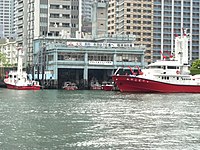 | |
| Abbreviation | 東京消防庁 |
|---|---|
| Formation | March 7, 1948 |
| Type | Fire Department |
| Legal status | Municipal Fire Service |
| Headquarters | 1-3-5 Ōtemachi |
| Location | |
Fire Chief | Toshio Andō |
Budget | ¥245,932,000,000 (2015)[1] |
Staff | 18,408 |
Volunteers | 26,490 |
| Website | www |

The Tokyo Fire Department (TFD) (Japanese: 東京消防庁, Tokyo Shōbōchō) is a fire department headquartered in Ōtemachi, Chiyoda, Tokyo, Japan.[2] The TFD was formed on March 7, 1948, and is responsible for protecting the Tokyo Metropolis Area. The Fire Department is the largest urban fire department in the world. Covering the 23 Wards of Tokyo and parts of Western Tokyo, it provides assistance in case of fires, biological, chemical, and radioactive hazards, as well as earthquakes and flooding. First response for medical services and all types of rescues are also provided. The department handles varied challenges from urban settings to mountain forests. The department is part of the Tokyo Metropolitan Government. However, this department is distinguished from Fire and Disaster Management Agency, which is an external agency of the Ministry of Internal Affairs and Communications.
Duties and services[]
Firefighting operations
- Fire suppression
- Technical rescue
- Hazardous materials mitigation
- Airport fire and rescue
- Seaport fire and rescue
Fire prevention
- Inspection of buildings
- Hazardous materials safety measures
- Fire prevention inspection
- Fire protection management guidance
- Fire investigation
Emergency medical services
- First-aid education and training
- Emergency telephone consultation
Earthquake preparedness
- Fire rescue task forces (Hyper Rescue)
- Volunteer fire corps
Fire districts and fire stations[]
Overall of stations in Tokyo Metropolis Area
- Fire station divisions: 3
- Fire stations: 81
- Fire station branches: 207
Fire districts and fire stations
- 1st Fire District: Marunouchi, Nihonbashi, Akasaka, Kōjimachi, Rinko, Takanawa, Kanda, Shiba, Kyobashi, Azabu
- 2nd Fire District: Shinagawa, Den-en-chōfu, , Kamata, Ebara, Yaguchi, Ōmori
- 3rd Fire District: Meguro, Shibuya, Setagaya, ,
- 4th Fire District: Yotsuya, Nogata, Ushigome, Suginami, Shinjuku, Ogikubo, Nakano
- 5th Fire District: Koishikawa, Oji, Hongo, , Toshima, , Ikebukuro
- 6th Fire District: Ueno, Ogu, Asakusa, Senju, , Adachi, Arakawa,
- 7th Fire District: Honjo, Honden, , Mukojima, Kanamachi, Fukagawa, Edogawa, Joto, Kasai
- 8th Fire District: Tachikawa, Akishima, Higashimurayama, Kiyose, Musashino, Chōfu, Kokubunji, Nishitōkyō, Mitaka, Koganei, Komae, Fuchū, Kodaira,
- 9th Fire District: Hachiōji, Fussa, Ōme, Tama, Machida, Akigawa, Hino, Okutama
- 10th Fire District: Itabashi, , , Nerima, Hikarigaoka
Mobile units[]

Pumpers = 489
|
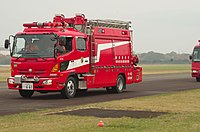
Rescue Trucks = 40
|
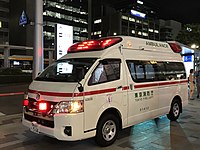
Ambulances = 259
|

Special trucks = 86
|

Aerial ladder = 86
|
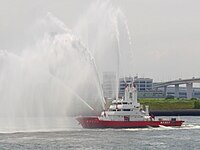
Fire boats = 10 |

Command units = 93 |
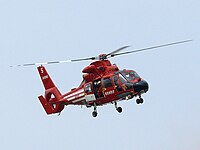
Helicopters = 7
|

Motorcycles = 20 |
(As of April 1, 2019)[3]
Demonstration and preparedness training[]
A few times a year, the department has demonstrations and preparedness training. These are small and others might be large-scale events.
Demonstration The demonstrations are mostly public awareness events for the people who live in the Tokyo area. This also shows the taxpayers where the funding of the department was spent, and the department's state of preparedness. This is also used as a recruiting tool for future firefighters. Commonly one sees a small demonstration every so often in district centers, schools, and shopping arcades. The firefighters would give rides, tours, or maybe let you touch equipment.

The biggest demonstration is Dezomeshiki. It's the New Year Tokyo Fire Department Review; and happens in January every year. They present all the resources and training that the Department currently are using. They perform a fake disaster where the firefighters use their equipment. They also set up a showroom for equipment and a small museum.
Preparedness training Every so often a fire district performs a preparedness training. They train with a fake disaster in a real district area. This training is for the firefighters, support staff, and local volunteers. The training means they can better know an area if a disaster happens.
The preparedness training also uses Mass Casualties Tags. These tags are used in major disasters. These tags give information about the person and sort out many who could be saved with the current status of medical service, a form of triage.


Technologies[]
Fire-fighting robotics
The department currently has 12 different types of fire fighting and rescue robots. These robots are designed to handle disasters that are too dangerous for personnel during an emergency. Some types of robots can shoot water or foam on to fires. One type can rescue a person and another type are able to move large objects. Currently all robots are controlled by remote operators.
Future firefighting robotics might have simple artificial intelligence to search for life and be able to move on terrain without operator's assistance.
Ranking system and uniforms[]
Rank insignias are on a small badge, pinned above the right pocket. Rank is denoted by stripes and Hexagram stars. The design of the insignias came from older Japanese-style military insignias. Some rank badges are different colors such as the fire jacket for a station commander.
Firefighter
|
Assistant Fire Sergeant
|
Fire Sergeant
|
Fire Lieutenant
|
Fire Captain
|
Battalion Chief
|
Assistant Chief
|
1st Assistant Chief
|
Deputy Chief
|
Fire Chief
|
- The dress uniforms are a blue suit and normal firemen wear jumpsuits in the same color with orange reflection stripes. A normal fireman's fire jacket are brown with orange stripes.
- Gray and white are reserved for Emergency medical services with their work uniform. They are mostly seen with a light blue raincoat over them on a call.
- Orange is reserved for rescuer where they wear a jump suit with the same color. The fire jacket are orange with yellow reflection stripes.
- Black fire jacket with yellow and silver reflection strips are for specialized firemen or officers.
History[]
Japan's first fire service was founded in 1629 during the Edo era, and was called Hikeshi (Japanese: 火消し, lit. Fire eraser). During the Meiji Period, when Japan opened its doors to the West, the Hikeshi was merged into the Tokyo Metropolitan Police Department in 1881. During this time period, pumps were imported and domestically produced, and modern firefighting strategies were introduced. The fire service would remain part of the police department until 1948 when the Tokyo Fire Department was organized.
Tokyo Fire Museum[]


The Tokyo Fire Museum is at Yotsuya 3–10, Shinjuku-ku. It has a large collection of historic fire fighting apparatuses. The museum has fire fighting history of the 17th and 18th centuries with large, scale-model dioramas showing scenes of destruction from past events. Models shows the uniforms and equipment that was used during that time. Other parts of the museum shows old pictures and films. They have scenes to show the birth of modern fire fighting vehicles, equipment, and fire suits. The museum has some of the very first pumps and hoses that were used. Twentieth-century firefighting history is also shown and the future of firefighting is exhibit at the museum, such as high-tech robots. A current working fire station is right next to the museum.
In popular media[]
- Firefighter! Daigo of Fire Company M the Manga and its Live Action TV series was based within the Tokyo Fire Department. Most of the cast act as Fire Department personnel.
- a Disaster film; has Tokyo Fire Department personnel as main characters in the film. They are rescuing people during the aftermath.
- Tokyo Magnitude 8.0 The Animation shows the Tokyo Fire Department saving the city from the aftermath of a major earthquake that hits central Tokyo.
- Fire Force En'en no Shōbōtai
See also[]
References[]
- ^ "[1]." Tokyo Fire Department. Retrieved on February 22, 2018.
- ^ "Website Policy." Tokyo Fire Department. Retrieved on May 16, 2010.
- ^ "Annual Report" (PDF). Tokyo Fire Department. Retrieved May 23, 2020.
External links[]
| Wikimedia Commons has media related to Tokyo Fire Department. |
- Tokyo Fire Department
- Tokyo Fire Department (in Japanese)
- Tokyo Fire Museum (in Japanese)
- Tokyo Fire Museum – Learn about Tokyo’s Past through its History of Fighting Fire
Coordinates: 35°41′19.8″N 139°45′41.6″E / 35.688833°N 139.761556°E
- Government of Tokyo
- Fire departments



